1977 was a monumental year that forever changed pop culture as we know it. Among the many events that marked it were the death of Elvis Presley, the release of the historic Apple II home computer, and the premiere of a curious little SF movie no one expected would kick off one of the biggest multimedia franchises in history – Star Wars.
The towering success of the film paved the way for all manner of Star Wars-related merchandise, tie-ins, and spin-offs. Though video gaming was still in its infancy (Pong was a mere five years old at this point), it was only a matter of time (and computing power) until the Star Wars brand branched out into gaming.
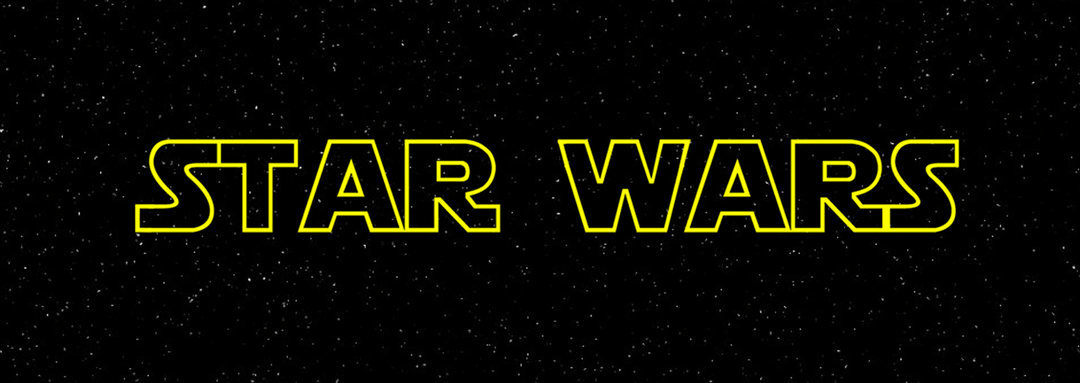
Since then, dozens of Star Wars-themed video games have been made. Many of them are still remembered fondly decades after release, and others rank as some of the finest titles in their respective genres.
With so much sheer history behind the IP, sorting the good from the bad can seem like a daunting task. But, never fear, we’re here to help – regardless if you are a SW fan or not, these are the best Star Wars games ever made, the absolute crème de la crème.
#1 The Best Star Wars Racing Game – Star Wars Episode I: Racer (1999)
There was an era when quality racing games were some of the most popular products in the gaming market. That’s not to say that they are without their fans even now – plenty of gamers still feel the need for speed.
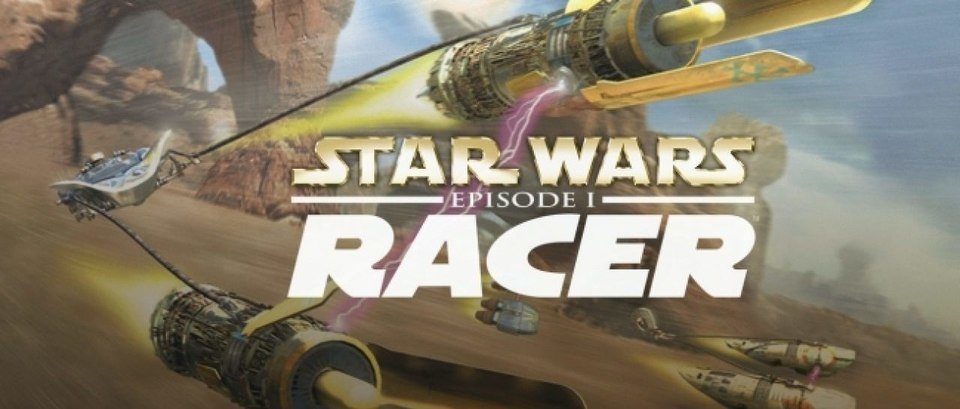
Among racing games, there was always a subset of futuristic racers where vehicles could achieve ludicrous speeds that exceeded 500 miles per hour. When the Phantom Menace came out in 1999 and featured a high-octane (or should that be “high-tibanna”?) racing sequence – a game devoted to exploring this dangerous sport was sure to follow.
Gameplay
As a podracer pilot, you will compete in races on several planets and over 20 different tracks. These range from the one on Tatooine (the racing track from the movie), to frozen wastes, urban centers, lava-filled caverns, and more. As you zap around, you will have to avoid crashing into walls, colliding with other racers, falling into magma, and other environmental hazards and obstacles.
If you take too much damage – or if you keep your boosters on for too long, causing your engines to overheat – your vehicle will be destroyed and you will respawn several seconds later. When you and your fellow racers are going that fast, this can mean the difference between winning and losing.
The levels are wonderfully designed, full of optional shortcuts, and requiring quick reflexes and equally keen wits if you want to win first place. In Tournament mode, you earn money that you spend on upgrading your podracer, increasing attributes such as acceleration and top speed.
Graphics & Audio
Being a pre-2000s game that was released across several platforms, Star Wars Episode I: Racer isn’t going to wow you in the graphics department. The podracers, with their unusual model designs, still look fun to drive and the tracks are plentiful enough to avoid quick repetition.
The sound is mostly made up of recycled sound effects and music from past Star Wars movies (including The Phantom Menace, of course).
Despite the meager poly-count and low-res texture quality, the first time you plunge over a massive cliff going six hundred miles an hour and landing in the ice below is still impressive – not to mention exhilarating.
Story
Though you can choose from a roster of 25 racers (including little Anakin Skywalker) and take them all the way to the top of the championship, there isn’t a story mode per se.
Like in most sports games, you participate for the sake of playing the game, not because of any unfolding narrative that you want to learn more of.
Overall Review/Final Thoughts
Arguably the best thing to come out of Phantom Menace (along with the Duel of the Fates), SW Episode I: Racer’s core gameplay is as rapid and rip-roaring as it ever was.
If you are looking for a hypersonic racing game in the tradition of Wipeout and F-Zero, give Ep I: Racer a try.
#2 The Best Star Wars Arcade Shooter – Star Wars: Rogue Squadron 3D (1998)
Besides the fantasy appeal of being a Jedi (or a Sith, we don’t judge), there was always one more role that every kid watching Star Wars imagined themselves as – a heroic X-Wing fighter pilot. Flying in tight formation until breaking off to intercept a wave of TIE Fighters, strategically taking out turbolaser turrets on enemy capital ships, and switching all power to front deflector screen.
LucasArts had made several excellent Space Flight Sims – one of which also made this list – which delved into the more technical side of being a spacecraft pilot, but Star Wars: Rogue Squadron 3D stripped all these micromanaging aspects down to their bare minimum, and instead focused on arcade-style action.
Gameplay
Over the course of sixteen story missions – ranging from classic search and destroy ops, to objectives where you must guard or rescue certain targets – you will pilot five aircraft: the traditional X-Wing, agile A-Wing, bulky Y-Wing bomber, anti-AT-AT snowspeeder, and the experimental V-Wing.
Not all of these will be available for every mission – they are unlocked according to your success parameters: how quickly you completed your tasks, your accuracy, enemies destroyed, etc. For this, the game awards you bronze, silver, and gold medals needed to uncover additional content, such as the option to revisit a mission with a different ship.
Graphics & Audio
The graphics in Rogue Squadron come with one big draw – the limited draw distance. Everything around you is concealed under a heavy fog effect (a necessary and unfortunate graphical limitation at the time), which results in it seeming like enemies and objects suddenly materialize into existence a short distance away from your vessel.
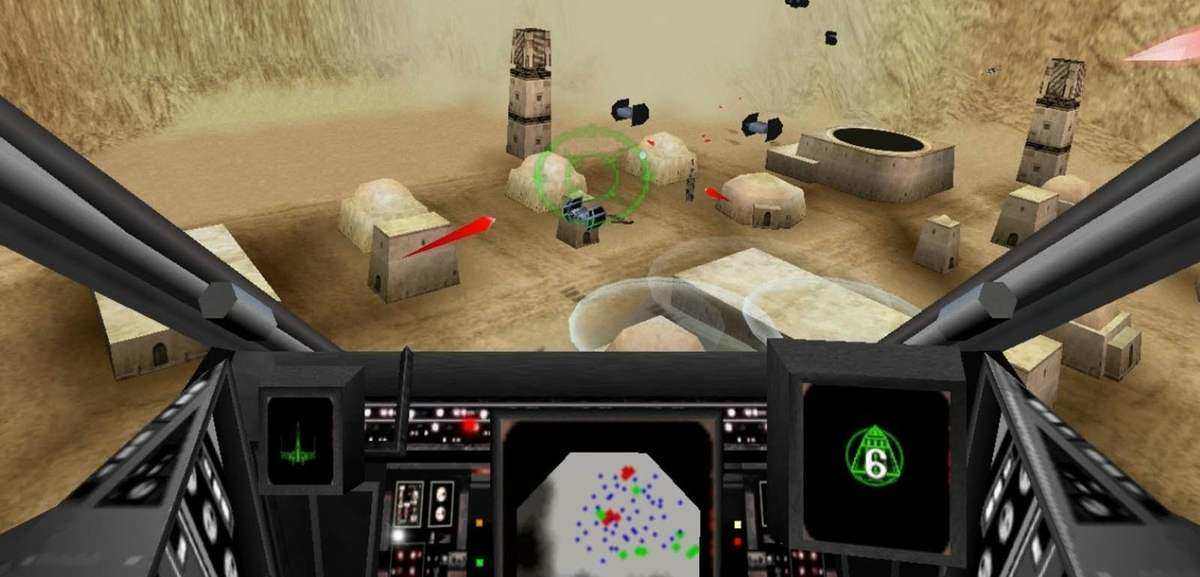
The terrain itself is monotonous – barren landscapes that are mostly devoid of any details such as trees and only with the occasional building or other points of interest.
It’s good then that the audio is much better – rich sound effects and many prominent voice actors go a long way to build a proper Star Wars atmosphere.
Story
Chronicling the adventures of the titular Rogue Squadron, a special Rebel Alliance unit founded by Luke Skywalker and consisting of the best starfighter pilots such as Wedge Antilles, the events of the game take place mostly between the end of Episode IV: A New Hope and those of Episode V: The Empire Strikes Back.
Following the destruction of the Death Star, the Galactic Empire is weakened, but by no means defeated. The Rebel Alliance, emboldened by this great victory, is taking the initiative to further disrupt the Empire’s operations and military capabilities.
The final level is set six years after the Battle of Endor (and the annihilation of the second Death Star), during the Dark Empire storyline. With the release of the sequel trilogy, certain plotlines of this story have been adapted (chiefly in Episode IX: The Rise of Skywalker), but Dark Empire as a whole is now no longer considered canon.
Overall Review/Final Thoughts
Star Wars: Rogue Squadron 3D distills the space warfare of the Star Wars universe into one glorious action-packed bundle of dogfighting delight.
Anyone who yearns to sit inside the cockpit of one of these iconic vehicles, without needing to worry about things like adjusting the front and rear shields – will find Rogue Squadron an energetic and easy arcade game to get into.
#3 The Best Star Wars Space Flight Simulator – Star Wars: TIE Fighter (Collector’s CD-ROM) (1995)
On the other end of the spacecraft flight game spectrum – both in terms of gameplay and thematically – we have TIE Fighter. Short for Twin Ion Engine Starfighter, it is a mass-produced standard offensive spaceship that comprises the bulk of the Galactic Empire’s Starfleet.
As in its predecessor, Star Wars: X-Wing (1993), the TIE Fighter lets us witness the Star Wars setting through the eyes of a hotshot pilot – but an Imperial instead of a Rebel one this time around.
Gameplay
Similarly to Rogue Squadron, you engage in missions where you will have a wide assortment of objectives – both primary (given to you by your superior officers) and sometimes secondary goals as well (given to you by a shadowy figure from the Emperor’s Inner Circle). Completing these will award you with promotions and medals, as well as unlock more advanced ships as the story progresses.
Unlike Rogue Squadron, the levels are all in outer space – there are no ground missions – and feature much more complex controls and ship management options. Besides the usual lasers, proton torpedos, and missiles, you also have ion cannons – that can be used to disable targets – jamming and tractor beams, and other new weapons.
If you take too much hull damage (after your shields have been depleted), your ship’s systems will start to malfunction until they’ve been repaired.
Overall, the action is fluid, and there is a greater number of ships – of all types and sizes – on the screen at once than in X-Wing, resulting in hectic space battles.
Graphics & Audio
Paradoxically, even though TIE Fighter came out several years before Rogue Squadron, its graphics exceed it in a lot of areas. The most obvious one is the lack of severely limited draw distances – you will be able to see capital ships miles off in the distance. This goes a long way to establish a strong suspension of disbelief that you really are in space and at the controls of a powerful spacecraft.
The CD-ROM version of the game comes with updated graphics, a higher resolution, better cutscenes, and voiceovers – and includes both expansion packs.
Story
TIE Fighter is the first Star Wars game to explore the Galactic Empire from a different point of view – as a necessary peacekeeping force that maintains order and stability in a deeply divided Galaxy.
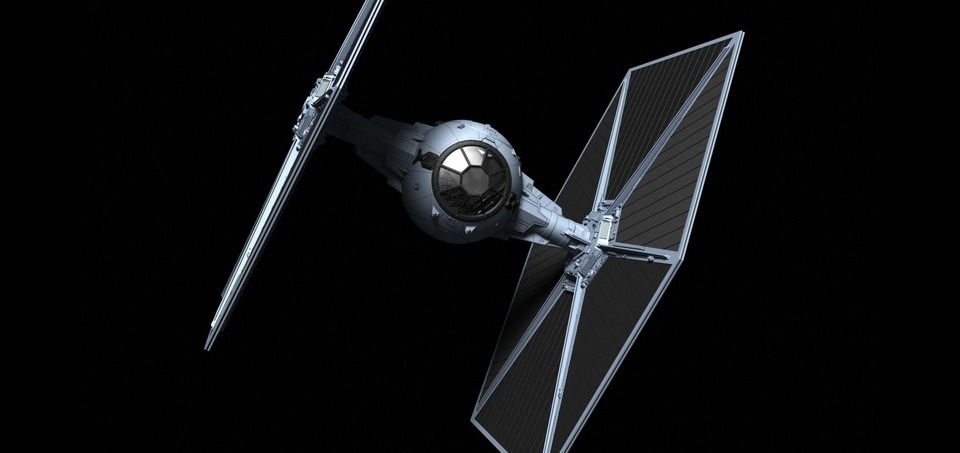
While the darker aspects of the Empire are definitely touched upon, you will be serving under mastermind Admiral Thrawn, a man who prizes tactics and logic, instead of wanton destruction and the spreading of pain and misery like Dark Side commanders often are.
Though Star Wars has long since been depicted as a complicated, morally-ambivalent setting, TIE Fighter was a pivotal moment for the franchise. It showed us the Galactic Empire as a believable organization – instead of thinly-veiled Nazi allegories – and why it had survived and thrived for so long.
Overall Review/Final Thoughts
Often included in numerous best PC games of all time lists, and it’s not hard to see why – if you can get past the primitive graphics of the day, TIE Fighter offers a lot of excellent spacefaring content for Space Flight Sims enthusiasts and Galactic Empire apologists.
#4 The Best Star Wars Tactical FPS – Star Wars: Republic Commando (2005)
Ever since Jedi Master Obi-Wan Kenobi off-handedly alluded to serving in the Clone Wars in his younger days, fans dreamed about learning more of this fantastically-named conflict. We finally got our chance in Episode II: Attack of the Clones. Although the move faltered and underperformed in most storytelling (and cinematic) facets, it did introduce several original and enduring elements to the Star Wars catalog.
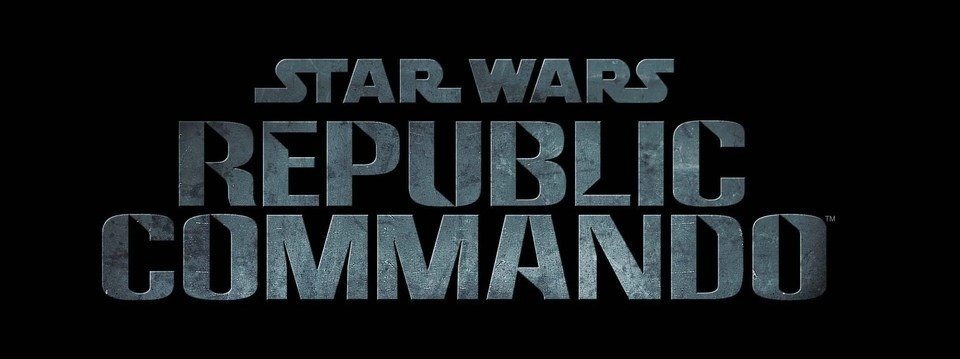
One of these were the Clone Troopers.
Gameplay
You are the commander of Delta Squad – an elite outfit of clone troopers in service to the Galactic Republic. With your three other squadmates, it is your job to undertake dangerous missions against the Separatists. These include assassination, sabotage, reconnaissance, and other clandestine special ops.
As the leader of the squad (and the only character you directly control), you will guide the rest of the team and give them orders when required: which positions to hold, when to slice (hack) a computer terminal, blow open a door, and so on.
Besides this tactical layer, the game is a pretty straightforward team-based FPS and you will spend the majority of your playthrough shooting up Separatist forces.
If you – or one of your squadmates – is downed, this doesn’t mean an automatic game over, as long as at least one of your fellow soldiers is standing, they can revive you and the rest of the team.
Graphics & Audio
A game from the mid-2000s through and through, the graphics are still serviceable if nothing too flashy. The biggest problem, visuals wise, is how dull many of the scenes look – futuristic interiors with little color variety and simple lighting. The character and weapon models fare considerably better, with a wide range of animations and poses.

The sound consists of the usual Star Wars SFX and, for the first time ever, includes licensed music – most notably the song Clones by Northern Irish band Ash.
Story
Another departure from the usual Star Wars noble hero/despicable fiend dichotomy, Republic Commando shows us the side of the expendable army grunt. Your player character, RC-1138 (Boss), RC-1262 (Scorch) the demolitions expert, RC-1140 (Fixer) the hacker, and RC-1207 (Sev) the sniper, are a rag-tag bunch, literally bred for war.
Despite the story ending on a rather dour cliffhanger and the sequel being canceled, Delta Squad proved to be popular enough that they were brought back in The Clone Wars TV series.
Overall Review/Final Thoughts
Star Wars is no stranger to first-person shooters – Dark Forces (1995), which marked the first appearance of fan-favorite Kyle Katarn, was a revolutionary game when it was released, helping to pioneer the verticality in FPS games we now take for granted.
A great FPS for everyone who likes teamwork in their shooters, to get the most out of Republic Commando, you will need this graphics fix.
#5 The Best Star Wars RPG – Star Wars: Knights of the Old Republic II: The Sith Lords (2005)
How do you make a sequel to one of the most beloved role-playing games of its generation? Simple – you take every feature that the original had and you revamp them, putting your own little twists on the mechanics and lore.
Like with the original Star Wars film trilogy, KoTOR I was a fairly by-the-numbers classic Star Wars story, the Episode IV: A New Hope of the series. KoTOR II is comparable to Episode V: The Empire Strikes Back – it is darker, more intricate, a natural evolution that takes the series in a new direction.
Gameplay
The gameplay is almost identical to that of KoTOR I – but bolstered with new weapons, armor, Force abilities, prestige classes (mutually exclusive Jedi and Sith ones), even different lightsaber styles. The game once again uses a d20 system that has been modified to work within the Star Wars setting.
The combat is real-time with pause and beside your main character, you can bring along and manage up to two additional companions.
The swoop bike racing and Pazaak card mini-games also return. Like in Fallout: New Vegas (which has the card game Caravan) and The Witcher 3 (the almost-unavoidable Gwent), Pazaak is now a better integrated – though still optional – diversion.
Depending on if you are playing a Light or Dark-Sided character, as well as your gender, you will recruit different companions and experience different content and reactions – making for a highly replayable game.
Graphics & Audio
Just like with the gameplay, the graphics are also mostly unchanged from the previous game. Since they use the same engine and came out within a year of each other, this is to be expected.
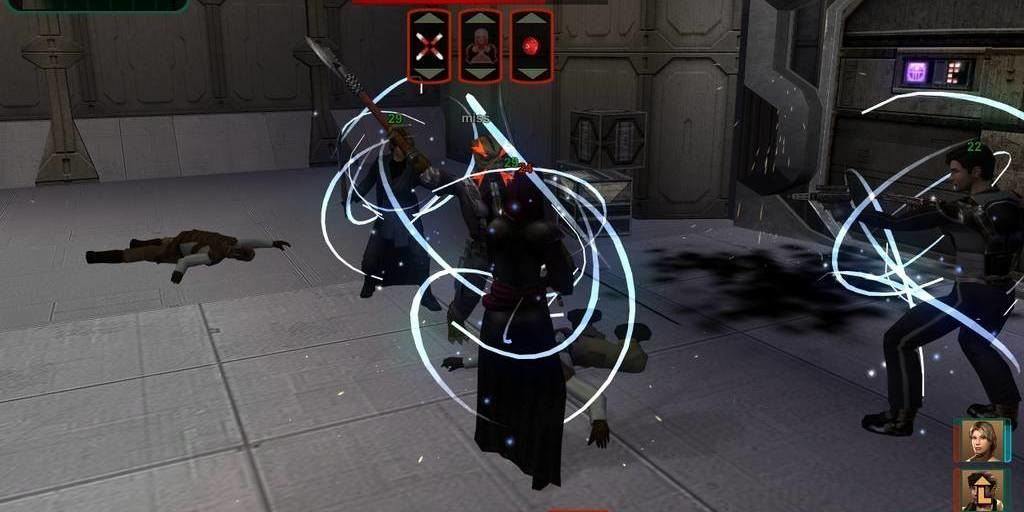
The design of the KoTOR series is undeniably Star Wars, but with little flourishes that clearly set it apart from the modern SW era and immediately make it obvious that, while this certainly is the same Galaxy far, far away we all know and love, it may not be the exact time period as the one depicted in the movies.
The music and voice acting are among the best that have ever graced a Star Wars game – with a standout performance by veteran theatre actress Sara Kestelman as the unforgettable voice of Kreia.
Story
If you’ve ever wondered what Star Wars would be like if they took the concept of the Force to its logical (and extreme) conclusions – KoTOR II The Sith Lords will be right up your alley.
Philosophical musings about living in an inherently black and white universe ruled by dogmatic religious orders of immense power and influence, questioning if we have free will if the Force predetermines, guides, and binds all our actions, and similar quandaries are discussed and explored at great lengths.
The game also provides scathing meta-commentary on the nature of video games (RPGs in particular) and their nonsensical rules – how video game characters draw strength from slaughtering hundreds of NPCs, or the inherent silliness of companions willing to join you and lay down their lives at your slightest whim after a single conversation when you meet them for the first time.
Overall Review/Final Thoughts
It’s a pretty safe bet that, without the KoTOR series, Mass Effect-like games would look and play a lot differently. Knights of the Old Republic II: The Sith Lords showed us that every franchise, no matter how stale and spent they’ve become, or how puerile they may seem on the surface, can still have interesting things to say – if you consider them from another, fresh angle.
To play the game as it was always intended – before LucasArts shortened the development cycle and left it in an infamously buggy and unfinished state – you will need The Sith Lords Restored Content Mod.
#6 The Best Lightsaber Combat in a Star Wars Game – Star Wars Jedi Knight: Jedi Academy (2003)
When you boil it down to a single ingredient, the coolest thing about Star Wars, the one component that everyone immediately associates with it – is the lightsaber. A weapon that encapsulates the entire SW mythos and sets it apart from other fictional settings.
The lightsaber had long been a necessary tool for every Force-sensitive video game protagonist, but it was just another item in your arsenal – albeit an indispensable one.
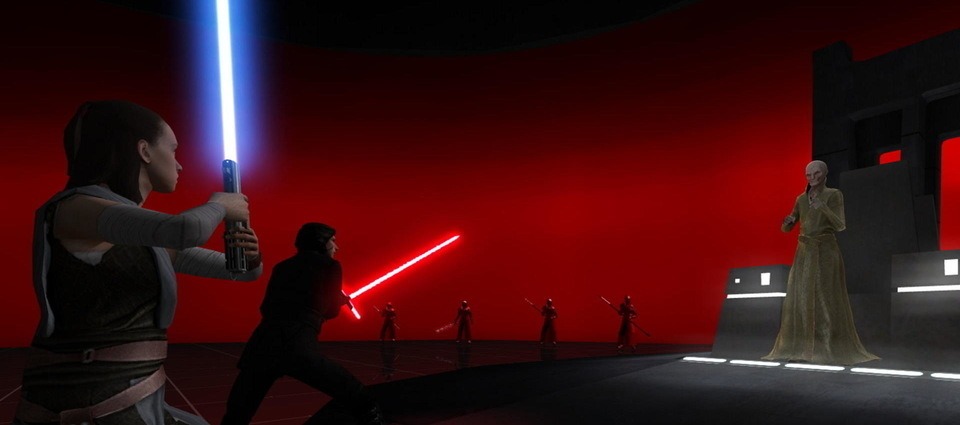
It wasn’t until Star Wars Jedi Knight II: Jedi Outcast that the lightsaber became your go-to device for every situation, from combat to puzzles. Jedi Academy further refined this, resulting in the finest, most faithful video game lightsaber combat to date.
Gameplay
Right from the first scene, Jedi Academy rectifies Jedi Outcast’s biggest flaw – you don’t have to spend a good initial portion of the game as an “ordinary” person. Instead, you are a lightsaber-wielding Jedi Padawan from the outset.
New armaments, Force powers, and moves are further expanded with the option of dual-wielding lightsabers or using a double-bladed lightsaber. While you begin the game with a single lightsaber (you can choose the hilt type and beam color), you will be able to switch to one of the other types (or stick with a single blade) about two thirds into the game.
Keeping with the theme, more enemies will be Force practitioners and you will partake in some phenomenal lightsaber duels.
Unlike many other Star Wars games where you had to pummel an opponent repeatedly with a lightsaber until they were beaten (looking at you, The Force Unleashed!), Jedi Academy understands that this is an overwhelming weapon of pure devastation, and most enemies (yourself included) can go down from a solitary well-placed blow.
Graphics & Audio
What Jedi Academy lacks in advanced visuals, it makes up for with splendid level design – you will visit various planets and locations all across the Galaxy. Some of these areas are urban, others (literally) in the middle of nowhere, but they are all distinctly crafted and leave a lasting impression long after you’ve finished the game.
The voice acting is, as is customary for Star Wars projects, of the highest quality and features such talents as Bastila Shan (one of the companions from Knights of the Old Republic I) actress Jennifer Hale, who plays the female version of our main character.
Story
After picking your gender, species, and appearance, we are introduced to our protagonist – Jaden Korr, a Force prodigy who learned how to construct a lightsaber without any previous training. Because of this rare feat, Jaden is admitted to the Jedi Academy on Yavin 4, where s/he will train under Jedi Masters Luke Skywalker and Kyle Katarn.
Upon arriving on the planet, Jaden and fellow student Rosh Penin are shot down and they must fight their way to the Academy. A mysterious new Dark Jedi cult calling themselves the Disciples of Ragnos has emerged to threaten the Galaxy, and, with the help of mentor Kyle Katarn, you will be sent out on missions where you will both collect information about their motives and whereabouts, and protect the peace like the Jedi of old once did.
While the story doesn’t have the same emotional resonance as the one from Jedi Outcast, it is still a satisfying space-opera action romp.
Overall Review/Final Thoughts
If KoTOR II is about comprehending that it takes more than a laser sword to be a Jedi (or Sith), then Jedi Academy is all about being a proactive Jedi Knight, with very little moralizing and introspection.
Out of every Star Wars game, it comes the closest to match the same danger and intensity that the movie lightsaber duels had – in line with Akira Kurosawa’s blink-and-you’ll-miss-it samurai showdowns.
#7 The Best Star Wars MMORPG – Star Wars: The Old Republic (2011)
The second Star Wars massively multiplayer online role-playing game, The Old Republic superseded Star Wars Galaxies (which was shut down to make room for it) as a bright and hopeful game that many of its developers expected would be a “World of Warcraft-killer”.
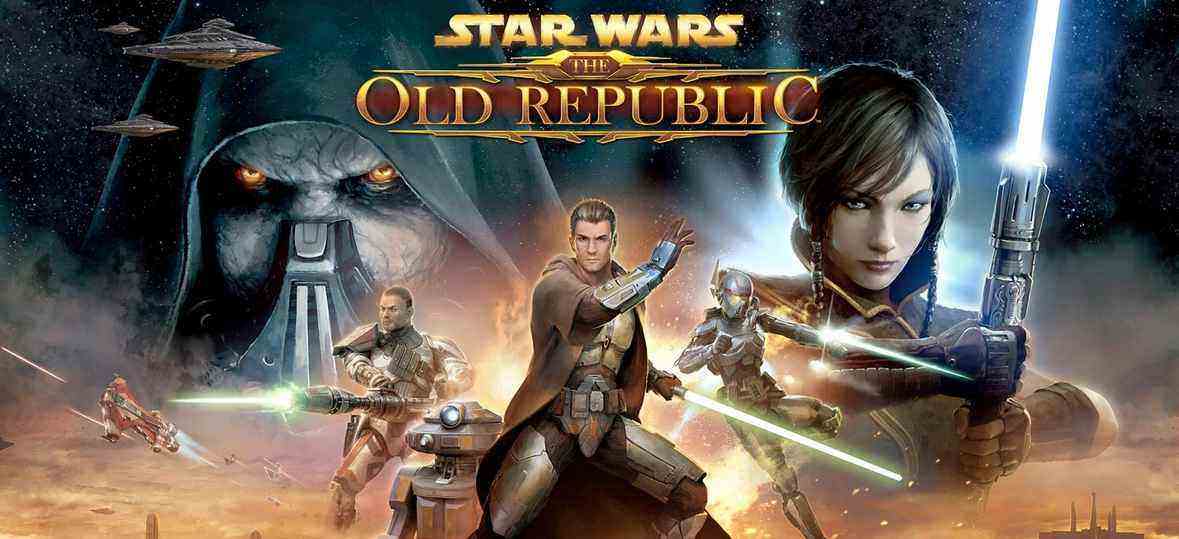
Of course, as is the case with every other WoW-killer – this proved to be just a pipe dream. Which doesn’t mean that there’s no reason to play The Old Republic. Far from it.
Gameplay
Utilizing standard MMORPG gameplay conventions, SWTOR lets you pick a side – the Galactic Republic or the Sith Empire – your species (Human, Cyborg, Twi’lek, Zabrak, Miraluka, Mirialan, Chiss, Rattataki, and Sith Pureblood.
The Cathar, Togruta, and Nautolan races are available after you unlock them in the Cartel Market), and class (Jedi Consular, Jedi Knight, Smuggler, and Trooper for the Galactic Republic. Bounty Hunter, Imperial Agent, Sith Inquisitor, and Sith Warrior when playing for the Sith Empire).
Some of the races are restricted to certain classes (the Sith Pureblood can only be Sith Inquisitors and Sith Warriors, for example) and each class will also be able to pick from two advanced classes (The Jedi Knight will be able to become a Jedi Guardian or Jedi Sentinel, and so on) later in the game.
As you advance in levels, you gain new abilities, learn skills taught by trainers, meet companions, and make Light and Dark side choices (regardless of faction choice) which will close off certain parts of the story while opening up others.
Graphics & Audio
As in the majority of online games, the graphics are designed with optimization in mind – to be playable across a wide range of different configurations and internet speeds. Consequently, the characters look somewhat plastic and glossy.
One of the most expensive games ever made, SWTOR’s production values when it comes to sound are simply amazing, the game has over 200.000 lines of recorded dialogue, and are best enjoyed with an equally great gaming headset.
Story
Three hundred years after the events of Knights of the Old Republic II: The Sith Lords, the Sith Empire has once again returned to threaten the Galactic Republic. Heroes (and villains) on both sides will emerge in order to break the stalemate between these two factions.
Each class has a unique three-act storyline written by some of the best video game storytellers in the business, giving the game a very high dose of replayability. SWTOR is still being updated with new expansion packs (the most recent one, Onslaught, was released in October 2019) that introduce new content and raise the level cap.
Overall Review/Final Thoughts
SWTOR has been free-to-play since November 2012 – a mere several months after it was released. While it was never the huge hit Electronic Arts wanted it to be, its story campaign is a treat for any Star Wars fan – especially those that played the first two KoTOR games and wanted to see how several plot threads that were introduced in The Sith Lords would be resolved.
#8 The Best Star Wars Action-Adventure – Star Wars Jedi: Fallen Order (2019)
Since Disney acquired the Star Wars brand in 2012 and “restructured” LucasArts (a fancy way of saying they de facto shut the studio down), there hadn’t been a proper single-player Star Wars game in years. Many promising titles, such as Star Wars 1313 and Project Ragtag (helmed by Uncharted creator Amy Hennig and developed by now-defunct Visceral Games) were canceled mid-development.
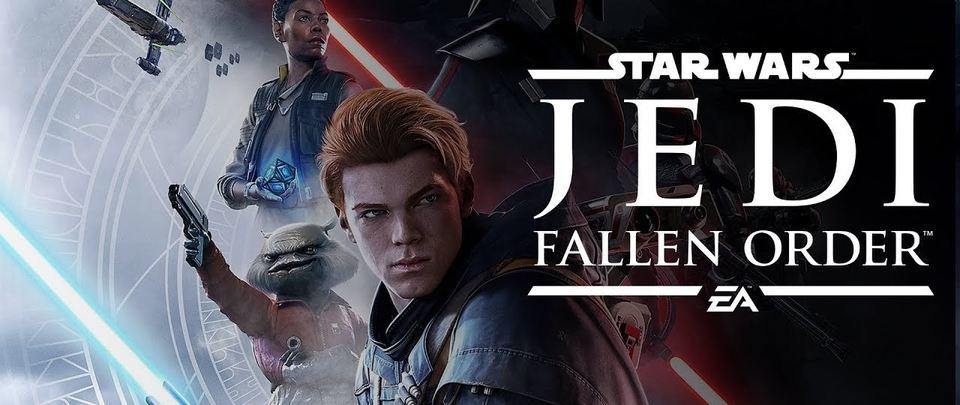
So when Fallen Order, a brand-new single-player-focused Star Wars game set to be published by Electronic Arts – the same EA that “killed” Project Ragtag – was announced, fans were, naturally, overcome with trepidation.
Luckily, Fallen Order turned out to be one of the best SW games ever made – a much-needed unexpected hit that rejuvenated Star Wars gaming and proved that there will always be a market for terrific single-player games.
Gameplay
Fallen Order is a strange (but enticing) combination of disparate genres. Its combat takes the Dark Souls-like approach, where you have to carefully dodge, parry, and look for openings in the enemy’s attack and movement patterns. Not to mention the meditation circles that function like DS’ bonfires – checkpoints where you can heal up, but which also cause all the defeated enemies to respawn.
Another clear influence are Metroidvania games. From them, Fallen Order copies the same approach of returning to previously unreachable sections of levels once you’ve acquired new abilities that enable you to access them.
The final ingredient is a generous dose of Uncharted – platforming, puzzles, and pathos.
Together, they congeal to form a first-class AAA game with rewarding, meaty combat and gratifying gameplay.
Graphics & Audio
The newest game on this list, Fallen Order takes full advantage of contemporary graphics and modern game development solutions, such as having the main character be brought to (digital) life through extensive motion capture of his actor, Cameron Monaghan (best known for his roles in the US version of Shameless and as the Jerome and Jeremiah Valeska twins from the Gotham TV show).
Famous Mongolian throat singing rock band The Hu recorded the song “Sugaan Essena” which is prominently featured in the game. Contrary to popular belief, the song isn’t sung in Mongolian, but is in fact performed in a fictional Star Wars language.
Story
Five years after the infamous Order 66 has decimated the Jedi and left them all but extinct, Cal Kestis, who was a child Padawan apprentice when the Clone Troopers betrayed and killed his Jedi Master, is hiding from the nascent Galactic Empire.
After years of suppressing his true nature, he is revealed as a Force-sensitive when he uses the Force to save his friend. The Empire is thus alerted to his existence and two Inquisitors are dispatched to hunt him down. His cover blown, Cal has no other choice than to pick up the mantle of Jedi once more.
The story does an excellent job of connecting Fallen Order with the old movies, as well as the new TV shows (Clone Wars, Star Wars Rebels) and movies such as Rogue One.
Overall Review/Final Thoughts
Exactly what Star Wars games have long since needed – a high-budget title made by some of the best developers in the business, Jedi: Fallen Order is an action-adventure extravaganza that you can enjoy even if you don’t particularly care for Star Wars.
For the rest of us SW aficionados, it’s a double helping: a great game and a great Star Wars experience, all wrapped up in one scrumptious package.
Final Words
Star Wars games have been coming out since 1982. During that time, they’ve managed to cover just about every possible genre there is. Their contribution to gaming – as a hobby and as a profession – is incalculable and will surely withstand the test of time.
No matter what sort of video games you prefer, these are the best Star Wars games for a good reason – there is something for everyone to be found here.
Happy gaming, and may the Force be with you, always.
Related: Star Wars: Battlefront II Best Class